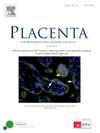在小鼠模型中,运动活动的增加并不能减轻高龄产妇的影响
IF 3
2区 医学
Q2 DEVELOPMENTAL BIOLOGY
引用次数: 0
摘要
高龄产妇(AMA)增加了妊娠并发症的风险,部分原因是胎盘受损。虽然怀孕期间的运动可以改善结果,但其减轻AMA影响的潜力尚未得到调查。我们在AMA小鼠模型中评估了运动的影响。方法将9周或34周龄的雌性与雄性配对,其中一组老年雌性在怀孕前4周和怀孕期间使用跑步轮。在妊娠第11.5天(GD)收集孕妇(N = 19 /组)。收集胎盘进行RNA测序(每组N = 17-20)。结果使用跑步轮的老年女性脂肪库(1.0±0.1 g)低于未使用跑步轮的老年女性(2.2±0.1 g);p & lt;0.0001),但与年轻女性无差异(0.8±0.1 g;p = 0.5)。两组老年母鼠的成活胎数(无胎:4.0±0.5,有胎:4.3±0.5)均低于年轻母鼠(8.3±0.5;p & lt;两个比较均为0.0001)。老年母胎冠臀长也较低(无胎轮:5.7±0.2 mm,有胎轮:5.5±0.2 mm,幼胎:6.6±0.2 mm;p & lt;两个比较均为0.0001)。接触车轮只影响胎盘中1个基因的表达,但在没有接触车轮和有接触车轮的年轻雌性和老年雌性中,分别有423个和967个基因的差异表达。胎盘转录组提示老年女性胎盘发育延迟。我们的模型再现了先前报道的年龄对胎儿发育和胎盘转录组学的影响,但尽管肥胖减少,但自发性运动活动的增加并没有减轻这些影响。值得注意的是,老年小鼠自主运动活动的增加对胎盘基因表达几乎没有影响。本文章由计算机程序翻译,如有差异,请以英文原文为准。
Increased locomotor activity does not mitigate the effects of advanced maternal age in a mouse model
Introduction
Advanced maternal age (AMA) increases the risk of pregnancy complications, in part due to impaired placentation. While exercise during pregnancy can improve outcomes, its potential to mitigate the effects of AMA has not been investigated. We evaluated the impact of exercise in a mouse model of AMA.
Methods
Females were paired with males at 9 or 34 weeks of age, with one group of aged females having access to running wheels four weeks prior to and during pregnancy. Pregnant females (N = 19 per group) were collected at gestational day (GD) 11.5. Placentas were collected for RNA sequencing (N = 17–20 per group).
Results
Aged females with access to running wheels had lighter fat depots (1.0 ± 0.1 g) than those without (2.2 ± 0.1 g; p < 0.0001), but did not differ from young females (0.8 ± 0.1 g; p = 0.5). Both groups of aged females had fewer viable conceptuses (without wheels: 4.0 ± 0.5, with wheels: 4.3 ± 0.5) than young mice (8.3 ± 0.5; p < 0.0001 for both comparisons). Fetal crown-rump length was also lower in aged females (without wheels: 5.7 ± 0.2 mm, with wheels: 5.5 ± 0.2 mm, young: 6.6 ± 0.2 mm; p < 0.0001 for both comparisons). Placental expression of only one gene was affected by access to running wheels, but 423 and 967 genes were differentially expressed between young and aged females without and with access to wheels, respectively. Placental transcriptomes suggested delayed placental development in aged females.
Conclusions
Our model reproduced previously-reported effects of age on fetal development and placental transcriptomics, but these were not mitigated by increased voluntary locomotor activity, despite a reduction in adiposity. Remarkably, increased voluntary locomotor activity had almost no effects on placental gene expression in aged mice.
求助全文
通过发布文献求助,成功后即可免费获取论文全文。
去求助
来源期刊

Placenta
医学-发育生物学
CiteScore
6.30
自引率
10.50%
发文量
391
审稿时长
78 days
期刊介绍:
Placenta publishes high-quality original articles and invited topical reviews on all aspects of human and animal placentation, and the interactions between the mother, the placenta and fetal development. Topics covered include evolution, development, genetics and epigenetics, stem cells, metabolism, transport, immunology, pathology, pharmacology, cell and molecular biology, and developmental programming. The Editors welcome studies on implantation and the endometrium, comparative placentation, the uterine and umbilical circulations, the relationship between fetal and placental development, clinical aspects of altered placental development or function, the placental membranes, the influence of paternal factors on placental development or function, and the assessment of biomarkers of placental disorders.
 求助内容:
求助内容: 应助结果提醒方式:
应助结果提醒方式:


